Last Updated on December 12, 2022
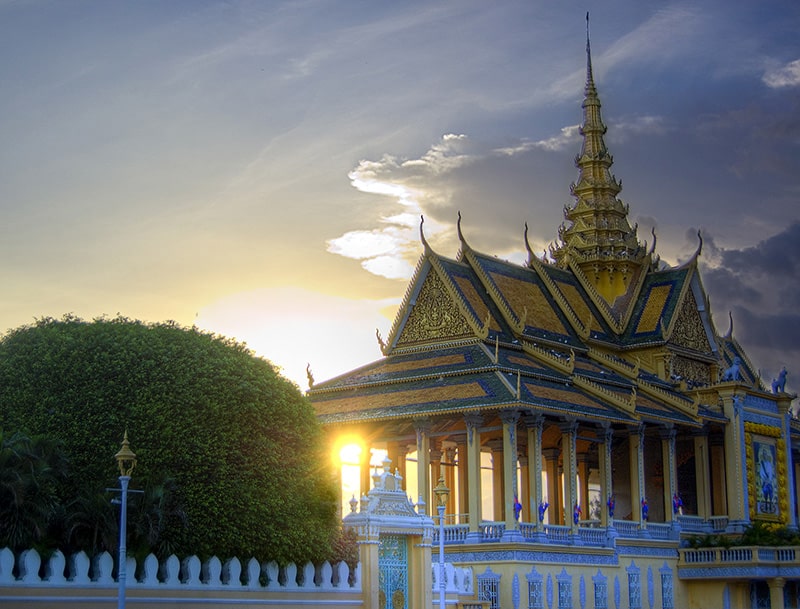
Cambodia’s capital Phnom Penh is a city full of stimulating experiences…
Estimated reading time: 7 minutes
By Jason Rupp and Carla Marie Rupp
Cambodia’s capital Phnom Penh is not just an epicenter of culture, economy and government. It’s also a city full of stimulating experiences. You’ll find many enjoyable things to do in Phnom Penh.
Cambodia is a country that was ravaged and debilitated by the Khmer Rouge more than a quarter-century ago. Today, however, it’s awe-inspiring to learn how the country is using tourism to ensure long-term peace and growth. Visit here and you find people who are genuinely eager for you to have fun. And, also, to show you where to enjoy good food and attractions.
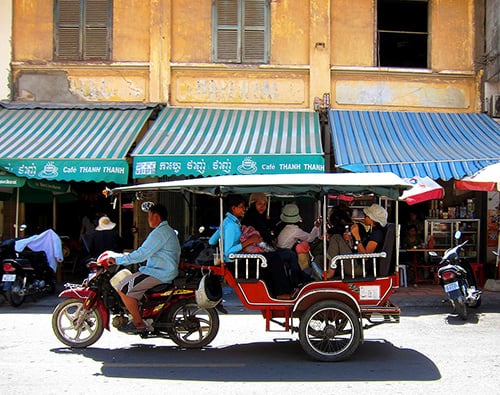
Things to Do in Phnom Penh: Start With a Tuk-Tuk
When we arrived in Phnom Penh, we decided to ride from the airport to downtown in a tuk-tuk. They’re those little taxi-like motorbikes you find throughout most of Southeast Asia, in which you can better enjoy the scenery. After check-in at our hotel we took motorbike taxis for cocktails at the Foreign Correspondents’ Club. It’s known to many here as simply the “F.”
It’s a restaurant / bar on the Tonle Sap river and during its happy hour the sunset views are intoxicating. During the tumultuous 1970s, journalists convened here, as well as at the palatial Hotel Le Royal nearby.
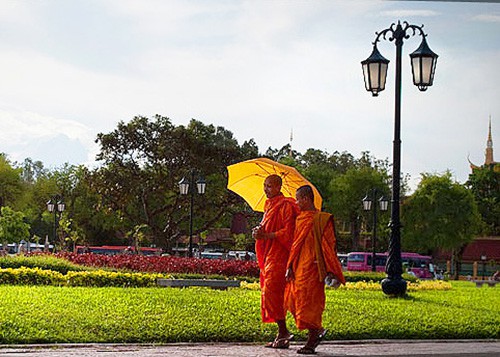
One day we discovered in the Phnom Penh Post, Cambodia’s English-language daily newspaper, that the Hash House Harriers, a running club, was to have their once-a-week run on the coming weekend.
We met up with them and other outdoor adventure-seekers in front of the train station at 2:00 Sunday afternoon. We then climbed into a big truck for a 30-minute trip, followed by a boat ride. Once ashore, we walked through the backwoods outside the capital snapping photos of the lush countryside. We also photographed the many congenial Cambodians we passed along the way. After we returned to the city we joined other travelers in a beautiful restaurant sampling of delicious Khmer (Cambodian) food.
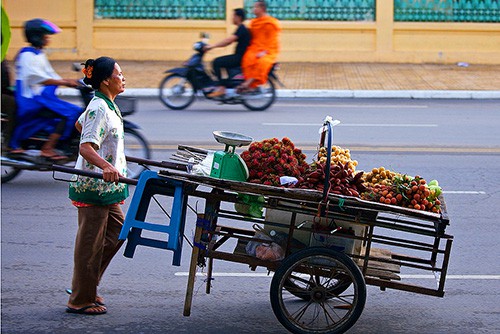
Food is an integral part of the cultural heritage of Cambodia. Also are the native-crafted items found in shopping meccas like the Central and Russian Markets. Those markets are must-sees for any visitor here, and bargaining is both fun and expected. The colorful scarves sold here would certainly make wonderful gifts.
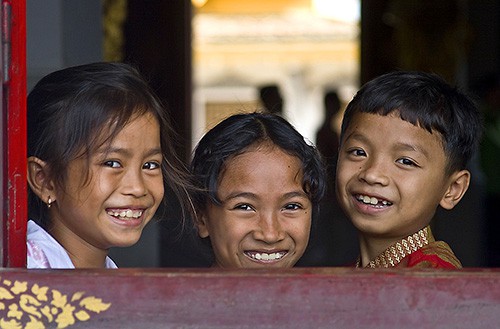
A Must-See in Phnom Penh
Another must-see attraction in Phnom Penh is the impressive National Museum of Cambodia, located just north of the Royal Palace. Along with its peaceful courtyard garden, the museum is a wonderful backdrop for photos.
As one would expect, the historic building contains many artifacts and sculptures. Among them is a 6th century statue of Vishnu, a major god in Hinduism. The museum’s Angkor collection is also stunning and contains a likeness of Shiva. It also contains several wrestling monkeys, and a seated Jayavarman VII, the Khmer Empire’s 12th-century ruler. The spectacular Silver Pagoda, near the Royal Palace, gets its name from the gleaming 5,000 silver tiles on the floor.
Another day we went to Wat Phnom temple up on a tree-covered hill. It’s a good place to take a walk (or an elephant ride!). Local legend says this was where Madame Penh discovered four statues of Buddha that came from the Mekong River. (Be sure to look for Madame Penh’s statue).A pagoda was built in 1373 to house them. Many still come here to pray for good luck, since over decades many Cambodians have suffered extreme hardships.
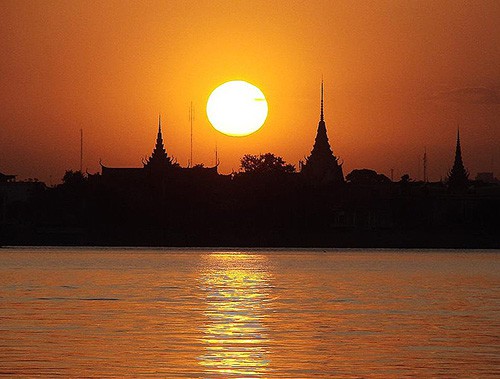
More Things to Do in Phnom Penh
Many tour guides tout “the killing fields” at Choeung Ek outside the city. The Tuol Sleng Genocide Museum, however, is also a tragic reminder of the atrocities heaped upon the Cambodian people. It all occured during the time of the rise to power of the notorious Khmer Rouge regime in 1975 to its fall in 1979.
Touring Tuol Sleng did prompt us to examine and purchase works by local authors about the tragedies that occurred here. Thankfully, a U.N.-backed tribunal testimony is still bringing more to light.
We talked with many Cambodians there about our sympathy for their people, while admiring their strength and fortitude for their suffering. It may be depressing, but it’s still important history.
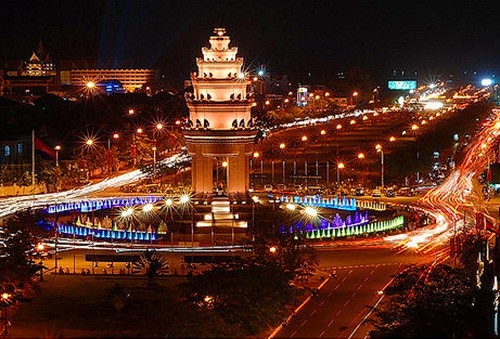
Cambodian Life and Culture
Throughout Phnom Penh we also got glimpses of many other aspects of Cambodia’s colorful life and culture. They included the Independence Monument, built in 1958 to commemorate the city’s independence from France in 1953. Also the Japanese Friendship Bridge (Chruoy Changvar Bridge) that spans the Tonley Sap River.
The bridge, incidentally, is where New York Times correspondent Sydney Schanberg was when the city fell in April 1975. Those who saw the movie The Killing Fields will recognize an area not far from French Embassy. There, on that horrendous day in 1975, 600 Cambodians had to leave the embassy while 800 foreigners were in refuge.
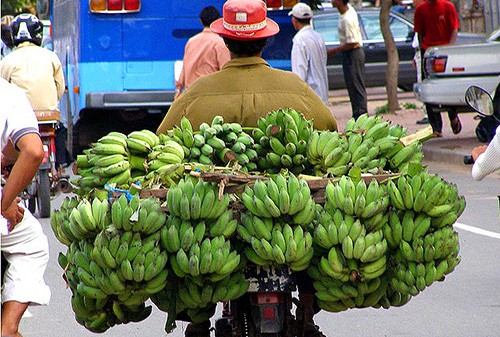
Our travels about Phnom Penh often left us speechless as we listened and learned. Actually being in Phnom Penh, after having heard so much about it for so many years, was remarkable. It is an adrenaline-filled destination full of educational and informative possibilities that span a wide range of emotions. We learned to be compassionate of Cambodia’s compelling history and understand why this important city needs and welcomes tourists.
Travel is the best peacemaker and we hope to go back one day and see and do even more. It’s important to connect with people. It’s also important to spend time in those city’s restaurants where proceeds go to helping charities rebuild lives.
Coming here could humbly change your outlook on life. It did ours.
If you go:
Ministry of Tourism of Cambodia
www.tourismcambodia.org
National Museum of Cambodia
Street 13 Sangkat Chey Chumneas
Khan Daun Penh
Phnom Penh
www.cambodianmuseum.orgg
Foreign Correspondents’ Club Restaurant, Bar & Hotel
363 Sisowath Quay
Phnom Penh
www.fcccambodia.com

Cambodia has been a huge part of my life for nearly ten years now. The people are wonderful, but have suffered so much injustice. Every tourist who comes brings some much needed cash to the local economy. But hopefully, you will also bring your patience, caring and understanding. Share what you can with the locals. Take photos and stories back to your country or post on your blog or Facebook, and you will help spread word about Cambodia to the world. Global Citizens are like global reporters. You can be a voice for the voiceless. Oh, and also, if you want to eat incredible French or Italian food for a fraction of what it costs elsewhere, I recommend Phnom Penh.
Thks for sharing the story about Khmer culture and next time if u go back to Cambodia visited the many islands that not alot of tourist know about
Thank you Saravan. I would love to get back to Cambodia. It’s a beautiful country with great people.